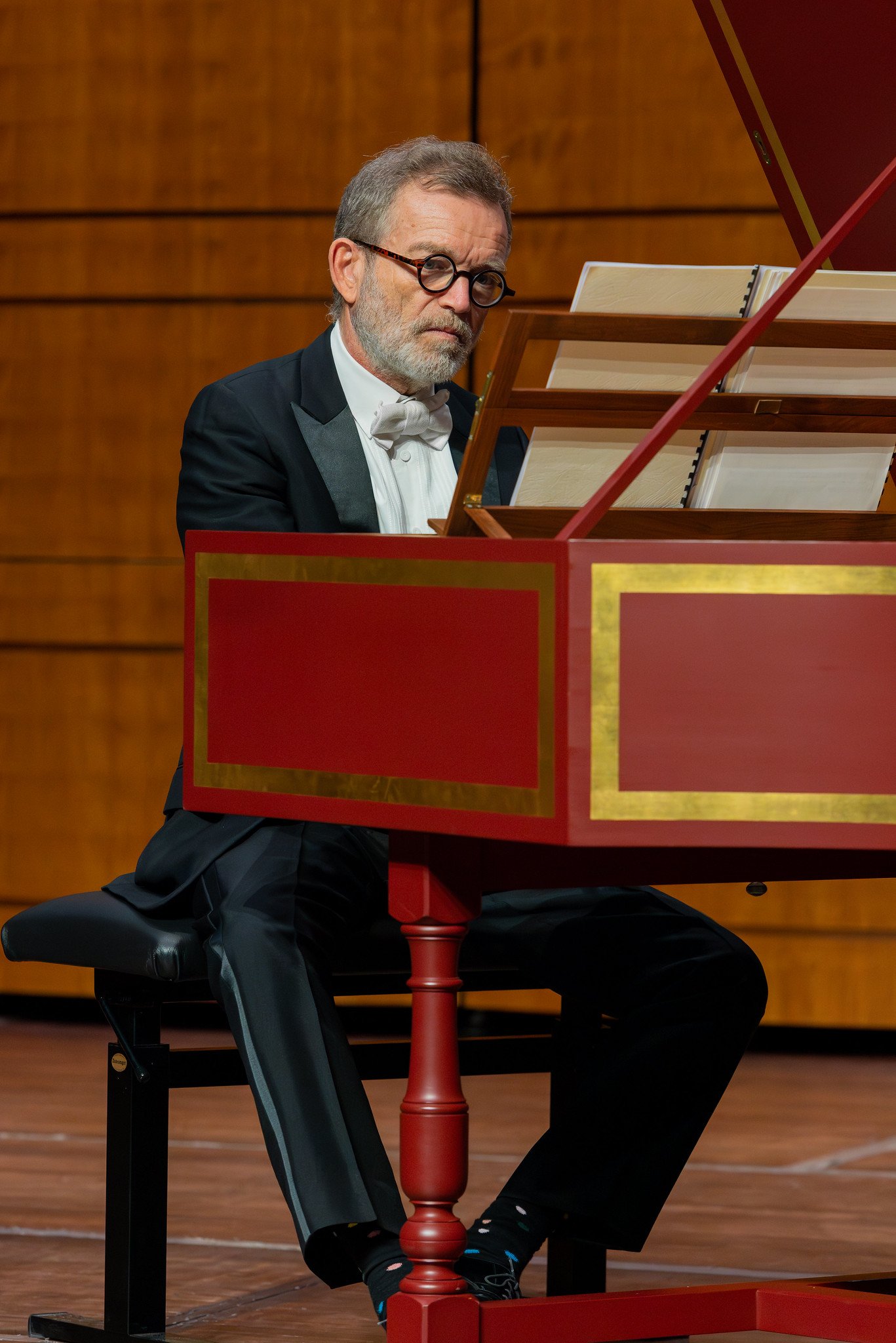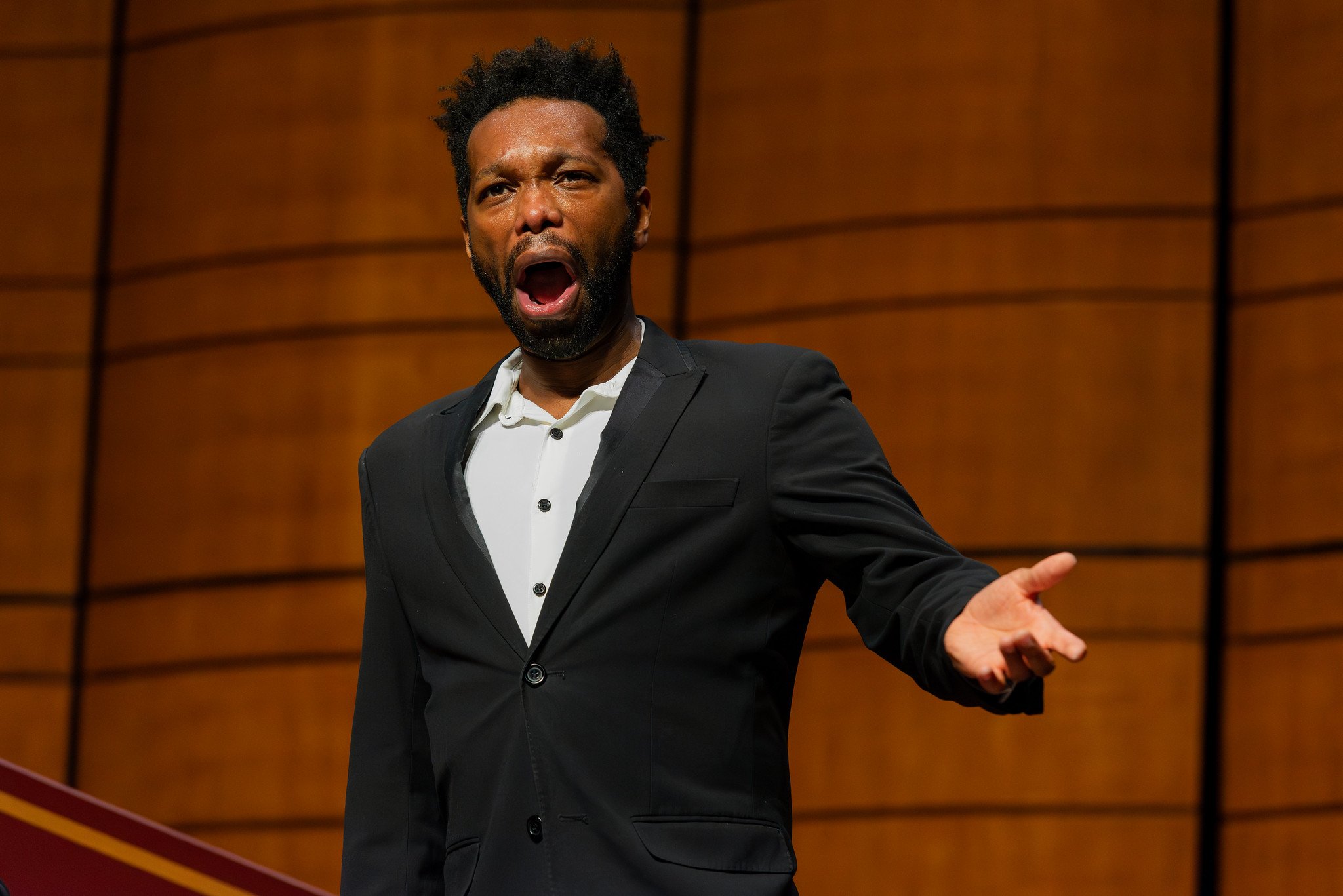Entering the Kennedy Center’s Terrace Theater for an Opera Lafayette performance often feels like boarding a time machine back to France in the 17-19th centuries. It’s a first-class cruise: the music is always highly enjoyable, and it will be performed authentically on instruments of that period by outstanding musicians. The adjectives that will typically come to mind will be elegant and exquisite, and like with most travel, you will leave richer for the experience.
l to r: Opera Lafayette’s cast for Couperin le Grand, harpsichordist Christophe Rousset, viol player Joshua Keller, bass-baritone Jonathan Woody, flutist Immanuel Davis, and violinist Jacob Ashworth. Photo by Caitlin Oldham; courtesy of Opera Lafayette.
OL’s vision statement includes: “Opera Lafayette gives new life to centuries’ old compositions, supported by scholarly research that highlights both the historical context of these works and their relevance to today’s world. Through this unique combination of entertainment and education, audiences discover opera in a whole new light”. In their last three seasons, OL has dropped us off in eras in France greatly influenced by women who held sway by their wits and their relationships with the King. For the 2021-2022 season, it was the era of Marie Antoinette married to Louis XVI, the next season the era of Madame de Pompadour, chief mistress of Louis XV; and this season we are transported to the era of Madame de Maintenon, a wife of Louis XIV married in secret. And I would add that nobody does time travel better than Opera Lafayette.
Before she was Madame de Maintenon, she became known to Louis XIV as a caretaker for some of his children, eventually becoming his mistress and then his wife in a secret ceremony; she remained his wife until his death. The influential Maintenon became known for starting a boarding school for girls, Maison Royale de Saint-Louis, where music was a core subject. She favored religious music and was suspicious of any music that generated feelings not in accord with religious vows; she disliked opera altogether for this reason. Until her influence, Louis XIV had favored using opera to expand his authority. She reigned in her husband, who had multiple official and unofficial mistresses, and she played to his increasing interest in religion as he moved into his later years; thereby, she also reigned in the music supported by the king. Secular music moved away from the court, mainly to Paris, and adopted new forms. There also developed a struggle within Paris with more freewheeling Italian music, vying for the soul of France; and of course, while each remained distinctive, there was a meld, as features of the Italian genre seeped into French music. These are the broad strokes of a complicated history underlying OL’s intriguing season and that influenced the music presented in Couperin le Grand.
left photo: Christophe Rousset. right photo: Jonathan Woody. Photos by Caitlin Oldham; courtesy of Opera Lafayette.
The primary focus of the evening’s concert, François Couperin, composed music for Louis XIV’s court recitals near the end of his reign. The highly regarded composer was known as Couperin le Grand to distinguish himself from other members of a musically talented family. This carefully focused program was arranged by renown harpsichordist and conductor Christophe Rousset who also played, beautifully I might add, anchoring the program. Mr. Rousset is founder and director of the French famed early music ensemble, Les Talens Lyriques. He was joined by Opera Lafayette’s concertmaster Jacob Ashworth on baroque violin, also by Joshua Keller on viola da gamba, and Immanuel Davis on baroque flute. Opera, in the era of Couperin’s influence, was not favored by the court. Likely for this reason, the program included only cantatas with vocals by bass-baritone Jonathan Woody; Mr. Woody has often appeared with Opera Lafayette and continues with the company as chorus personnel manager. Overall, the program included three cantatas, one by Couperin, separated by two chamber concert works by Couperin:
Cantate: La Morte d’Hercule by Louis Nicolas Clérambault
Concert no. 7: from “Les Goûts Réunis, ou Nouveaux Concerts” by François Couperin
Cantate: Ariane console per Bacchus by François Couperin
Intermission
Concert no. 3: from “Concerts royaux” by François Couperin
Cantate: L’Enlèvement d’Orithie by Michel Pignolet de Montéclair
l to r: Christophe Rousset, Joshua Keller, Immanuel Davis, and Jacob Ashworth. Photo by Caitlin Oldham; courtesy of Opera Lafayette.
The cantatas involved Mr. Woody as the narrator providing commentary on stories of Roman gods, focusing on the denouement and moral outcome of each story/cantata, rather than singing as a character. Mr. Woody’s weighty voice seemed to me a perfect match for these stories. The first cantata by Clérambault centered on the death of Hercules as an allegory for the death of Louis XIV, in praise for the revered king. The meaning of the actions in the cantatas are often open to interpretation and Clérambault’s as presented by OL was centered on warning lovers to be kind and respectful to one another. The second cantata was a piece recently discovered by Mr. Rousset and determined to be a work by Couperin. It tells a story of Bacchus’ pursuit of Ariadne, encouragement perhaps for wine drinkers (this was written for the French). The third cantata centered on the story of Boreas’ pursuit of Orithis; brutal in the legend that includes abduction and rape, OL chose words carefully to focus on advising lovers to demonstrate their worthiness as well as expressing their longing for the the object of their affection, if they want to be successful. In all three cantatas, bass-baritone Woody sang beautifully, embellishing the lines with emotion and expressive gestures, and to the delight of all, Mr. Woody returned with the ensemble for a marvelous encore, “Vos mépris chaque jour” by Michel Lambert, actually a highlight of the program.
The intervening Couperin pieces were quite pretty. The intricate interplay of instrument lines, such as one observes with string quartets, required I suspect, considerable virtuosity to play well and add in embellishments. Couperin’s works were written for harpsichord with additional instruments to be added as desired to create a chamber ensemble. I thought the pairing of harpsichord, viola da gamba, flute, and violin was a beautiful pairing. The different sections of the works played allowed different instruments to be the center of attention, especially the flute and violin. Mr. Ashworth’s violin was especially expressive, particularly in the last cantata where Boreas conjures up a storm to impress Orithia.
l to r: Jacob Ashworth, Christophe Rousset, Immanuel Davis, Jonathan Woody, and Joshua Keller. Photo by Caitlin Oldham; courtesy of Opera Lafayette.
All in all, Couperin le Grand was another gem of a concert by Opera Lafayette. My wife and I went home, had a glass of wine, and enjoyed the glow it had created.
The Fan Experience: Couperin le Grand was performed on October 22 in the Terrace theater of the Kennedy Center, sung in French with surtitles in English. All Opera Lafayette performances are also performed in NYC, this one on the following day, October 23, at the Kosciuszko Foundation. Typically, OL’s education efforts include online presentations and discussions on the upcoming performance. Two Salon Series videos, Part I and Part II covering the Era of Madame de Maintenon, are currently available online. There was also a pre-opera discussion one hour prior to the performance featuring Opera Lafayette’s Founder Ryan Brown and musicologist Saraswathi Shukla.
The next installment of the Era of Madame de Maintenon is titled From Saint-Cyr to Cannons: Moreau and Handel’s Esther to be performed at the Terrace Theater on February 8 and in St. Peter’s Church in NYC on May 9. This will be an orchestral concert with several vocalists. The climax of this season will be Mouret’s Les Fêtes deThalie, a modern premiere of the opéra-ballet, to be performed in the Terrace Theater on May 3, 4 and at the El Museo del Barrio in NYC on May 7.





